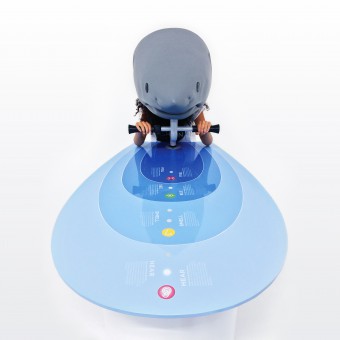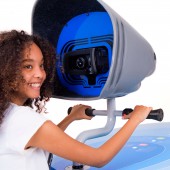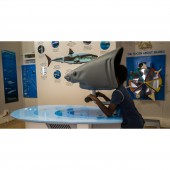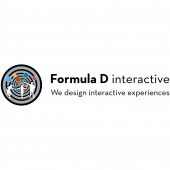Shark Sense VR Virtual Reality Exhibit by Formula D Interactive |
Home > Winners > #60000 |
 |
|
||||
| DESIGN DETAILS | |||||
| DESIGN NAME: Shark Sense VR PRIMARY FUNCTION: Virtual Reality Exhibit INSPIRATION: The objective was to get children to better understand and empathize with sharks, the Formula D interactive (FDi) team therefore created a first-‘person’ experience where the user interacts with the ocean through a shark’s perspective. The experience demonstrates, with immersive and tactile feedback, the different senses sharks use to survive. Because the VR headset is a single user device, the FDi team ensured the design included the people standing around the exhibit so that they too could be learning something through observation, even though not directly interacting with the exhibit. UNIQUE PROPERTIES / PROJECT DESCRIPTION: The Shark Sense 4D virtual reality exhibit debunks myths about sharks by providing visitors with an immersive VR game showcasing the senses sharks use to navigate. The exhibit is designed as a completely self-contained unit, enabling visitors to enjoy the VR content without assistance or bothersome cables. The VR and haptic technology are housed safely within the unit and created a 4D experience that engage most of the visitors' senses for a 4D fun and educational experience. OPERATION / FLOW / INTERACTION: While playing, visitors navigate the ocean from a shark's perspective by placing their head in the VR headset mounted into the shark head, and moving the shark head left and right. As they navigate the 3D environment, directional audio cues mimic the shark's sense of hearing, while a fan generating air flow alludes to the sense of smell sharks have. Vibrations in the handle-bars of the virtual reality exhibit mimic the electromagnetic field sharks detect when they are close to their prey. PROJECT DURATION AND LOCATION: The project was conceptualised and produced as a working prototype at the Shark Education Centre in Cape Town in 2016, and was then redesigned and fabricated in 2017 and exhibited at the Frost Museum of Science in Miami, Florida in 2017. FITS BEST INTO CATEGORY: Product Engineering and Technical Design |
PRODUCTION / REALIZATION TECHNOLOGY: The design process started with understanding the objective. It was quickly established that a "first person" experience would provide Formula D interactive with the best platform to achieve their specific objective. VR was selected as the best-suited technology, but the fragility of the technology, especially in a high traffic centre, provided a significant design challenges. Formula D interactive then went about creating many prototypes, testing them with the target audience and adjusting the design based on the feedback from the test users until all concerns, challenges and objectives were satisfied. SPECIFICATIONS / TECHNICAL PROPERTIES: Exhibit Weight: 125kg Assembled Dimensions [mm]: 1460(l) x 1100(w) x 1453(h) TAGS: virtual reality, VR, exhibit, exhibit design, museum exhibit design, aquarium exhibit design RESEARCH ABSTRACT: The question of how to approach VR for public spaces was explored through in-depth analysis of approaches used by companies in the same and similar fields. Ultimately, the approach of a device that is hard mounted to the ceiling – with the ability to rotate, as with a periscope – and wires coming from the ceiling was modified into the self-contained unit under the table in the Shark Sense exhibit. The Shark Sense VR experience was user tested with children from both primary and high school age groups. Their feedback was analysed and the findings integrated into the final build. CHALLENGE: Two main challenges existed: The first, to create a VR experience that suited a public space and provided for social interaction and multiple user learning opportunities and, the second, to provide an immersive experience that was fun and engaging while still consistently and clearly describing the phenomena of the creatures in the real world. The exhibit structure itself also needed to be hardy enough to withstand constant use and sensitive enough to mimic smooth, fluid swimming. ADDED DATE: 2017-09-06 16:18:03 TEAM MEMBERS (8) : Creative Director: Michael Wolf , Graphic Designer: Jean-Jacques Rossouw , Graphic Designer: Linley Rall , Product Designer: Johan du Toit , Hardware Producer: Johan du Toit , Embedded Electronics Prototyper: Jennifer Cohen , Embedded Electronics Producer: Chris Fourie and Software Programmer: Duncan Cosser IMAGE CREDITS: Formula D Interactive, 2017. |
||||
| Visit the following page to learn more: http://bit.ly/2wPnAFV | |||||
| AWARD DETAILS | |
 |
Shark Sense Vr Virtual Reality Exhibit by Formula D Interactive is Winner in Interface, Interaction and User Experience Design Category, 2017 - 2018.· Read the interview with designer Formula D Interactive for design Shark Sense VR here.· Press Members: Login or Register to request an exclusive interview with Formula D Interactive. · Click here to register inorder to view the profile and other works by Formula D Interactive. |
| SOCIAL |
| + Add to Likes / Favorites | Send to My Email | Comment | Testimonials | View Press-Release | Press Kit |
Did you like Formula D Interactive's Interface Design?
You will most likely enjoy other award winning interface design as well.
Click here to view more Award Winning Interface Design.








